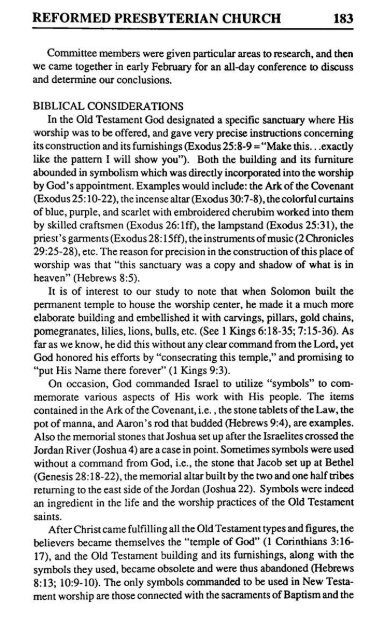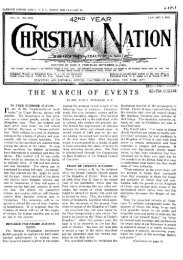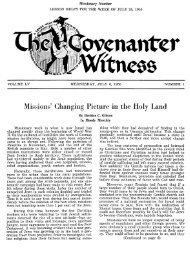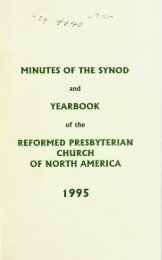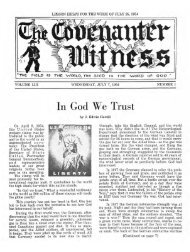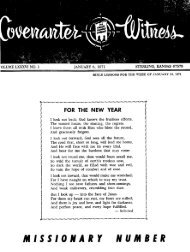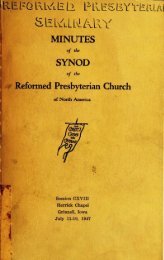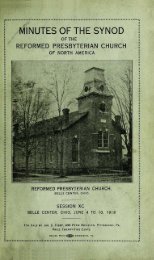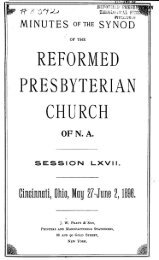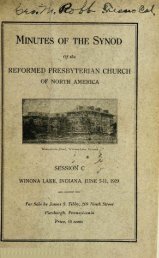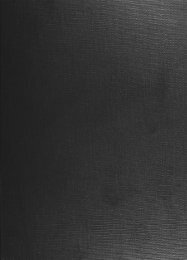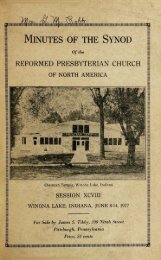- Page 1:
M i n u t e s o f t h e S y n o dan
- Page 4 and 5:
1993 MINUTES OF THE SYNOD OF THEJ.
- Page 10 and 11:
8 1993 MINUTES OF THE SYNOD OF THE9
- Page 12 and 13:
10 1993 MINUTES OF THE SYNOD OF THE
- Page 14 and 15:
12 1993 MINUTES OF THE SYNOD OF THE
- Page 16 and 17:
14 1993 MINUTES OF THE SYNOD OF THE
- Page 18 and 19:
16 1993 MINUTES OF THE SYNOD OF THE
- Page 20 and 21:
18 1993 MINUTES OF THE SYNOD OF THE
- Page 22 and 23:
20 1993 MINUTES OF THE SYNOD OF THE
- Page 24 and 25:
22 1993 MINUTES OF THE SYNOD OF THE
- Page 26 and 27:
24 1993 MINUTES OF THE SYNOD OF THE
- Page 28 and 29:
26 1993 MINUTES OF THE SYNOD OF THE
- Page 30 and 31:
28 1993 MINUTES OF THE SYNOD OF THE
- Page 32 and 33:
30 1993 MINUTES OF THE SYNOD OF THE
- Page 34 and 35:
32 1993 MINUTES OF THE SYNOD OF THE
- Page 36 and 37:
34 1993 MINUTES OF THE SYNOD OF THE
- Page 38 and 39:
36 1993 MINUTES OF THE SYNOD OF THE
- Page 40 and 41:
38 1993 MINUTES OF THE SYNOD OF THE
- Page 42 and 43:
40 1993 MINUTES OF THE SYNOD OF THE
- Page 44 and 45:
42 1993 MINUTES OF THE SYNOD OF THE
- Page 46 and 47:
44 1993 MINUTES OF THE SYNOD OF THE
- Page 48 and 49:
46 1993 MINUTES OF THE SYNOD OF THE
- Page 50 and 51:
48 1993 MINUTES OF THE SYNOD OF THE
- Page 52 and 53:
50 1993 MINUTES OF THE SYNOD OF THE
- Page 54 and 55:
52 1993 MINUTES OF THE SYNOD OF THE
- Page 56 and 57:
54 1993 MINUTES OF THE SYNOD OF THE
- Page 58 and 59:
56 1993 MINUTES OF THE SYNOD OF THE
- Page 60 and 61:
58 1993 MINUTES OF THE SYNOD OF THE
- Page 62 and 63:
60 1993 MINUTES OF THE SYNOD OF THE
- Page 64 and 65:
62 1993 MINUTES OF THE SYNOD OF THE
- Page 66 and 67:
64 1993 MINUTES OF THE SYNOD OF THE
- Page 68 and 69:
66 1993 MINUTES OF THE SYNOD OF THE
- Page 70 and 71:
68 1993 MINUTES OF THE SYNOD OF THE
- Page 72 and 73:
70 1993 MINUTES OF THE SYNOD OF THE
- Page 74 and 75:
72 1993 MINUTES OF THE SYNOD OF THE
- Page 76 and 77:
74 1993 MINUTES OF THE SYNOD OF THE
- Page 78 and 79:
76 1993 MINUTES Ub THE SYNUIJ Ub "l
- Page 80 and 81:
78 1993 MINUTES OF THE SYNOD OF THE
- Page 82 and 83:
80 1993 MINUTES OF THE SYNOD OF THE
- Page 84 and 85:
82 1993 MINUTES OF THE SYNOD OF THE
- Page 86 and 87:
84 1993 MINUTES OF THE SYNOD OF THE
- Page 88 and 89:
8(5 1993 MINUTES OF THE SYNOD OF TH
- Page 90 and 91:
88 1993 MINUTES OF THE SYNOD OF THE
- Page 92 and 93:
90 1993 MINUTES OF THE SYNOD OF THE
- Page 94 and 95:
92 1993 MINUTES OF THE SYNOD OF THE
- Page 96 and 97:
94 1993 MINUTES OF THE SYNOD OF THE
- Page 98 and 99:
96 1993 MINUTES OF THE SYNOD OF THE
- Page 100 and 101:
98 1993 MINUTES OF THE SYNOD OF THE
- Page 102 and 103:
100 1993 MINUTES OF THE SYNOD OF TH
- Page 104 and 105:
102 1993 MINUTES OF THE SYNOD OF TH
- Page 106 and 107:
104 1993 MINUTES OF THE SYNOD OF TH
- Page 108 and 109:
106 1993 MINUTES OF THE SYNODTJF TH
- Page 110 and 111:
108 1993 MINUTES OF THE SYNOD OF TH
- Page 112 and 113:
110 1993 MINUTES OF THE SYNOD OF TH
- Page 114 and 115:
112 1993 MINUTES OF THE SYNOD OF TH
- Page 116 and 117:
114 1993 MINUTES OF THE SYNOD OF TH
- Page 118 and 119:
116 1993 MINUTES OF THE SYNOD OF TH
- Page 120 and 121:
118 1993 MINUTES OF THE SYNOD OF TH
- Page 122 and 123:
120 1993 MINUTES OF THE SYNOD OF TH
- Page 124 and 125:
122 1993 MINUTES OF THE SYNOD OF TH
- Page 126 and 127:
124 1993 MINUTES OF THE SYNOD OF TH
- Page 128 and 129:
126 1993 MINUTES OF THE SYNOD OF TH
- Page 130 and 131:
128 1993 MINUTES OF THE SYNOD OF TH
- Page 132 and 133:
130 1993 MINUTES OF THE SYNOD OF TH
- Page 134 and 135: 132 1993 MINUTES OF THE SYNOD OF TH
- Page 136 and 137: 134 1993 MINUTES OF THE SYNOD OF TH
- Page 138 and 139: 136 1993 MINUTES OF THE SYNOD OF TH
- Page 140 and 141: 138 1993 MINUTES OF THE SYNOD OF TH
- Page 142 and 143: 140 1993 MINUTES OF THE SYNOD OF TH
- Page 144 and 145: 142 1993 MINUTES OF THE SYNOD OF TH
- Page 146 and 147: 144 1993 MINUTES OF THE SYNOD OF TH
- Page 148 and 149: 146 1993 MINUTES OF THE SYNOD Ub TH
- Page 150 and 151: 148 1993 MINUTES OF THE SYNOD OF TH
- Page 152 and 153: 150 1993 MINUTES OF THE SYNOD OF TH
- Page 154 and 155: 152 1993 MINUTES OF THE SYNOD OF TH
- Page 156 and 157: 154 1993 MINUTES OF THE SYNOD OF TH
- Page 158 and 159: 156 1993 MINUTES OF THE SYNOD OF TH
- Page 160 and 161: 158 1993 MINUTES OF THE SYNOD OF TH
- Page 162 and 163: 160 1993 MINUTES OF THE SYNOD OF TH
- Page 164 and 165: 162 1993 MINUTES OF THE SYNOD OF TH
- Page 166 and 167: 164 1993 MINUTES OF THE SYNOD OF TH
- Page 168 and 169: 166 1993 MINUTES OF THE SYNOD OF TH
- Page 170 and 171: 168 1993 MINUTES OF THE SYNOD Ub 1H
- Page 172 and 173: 170 1993 MINUTES OF THE SYNOD OF TH
- Page 174 and 175: 172 1993 MINUTES OF THE SYNOD OF TH
- Page 176 and 177: 174 1993 MINUTES OF THE SYNOD OF TH
- Page 178 and 179: 176 1993 MINUTES OF THE SYNOD OF TH
- Page 180 and 181: 178 1993 MINUTES OF THE SYNOD OF TH
- Page 182 and 183: 180 1993 MINUTES OF THE SYNOD OF TH
- Page 186 and 187: 184 1993 MINUTES OF THE SYNOD OF TH
- Page 188 and 189: 186 1993 MINUTES OF THE SYNOD OF TH
- Page 191 and 192: DIRECTORYOF THER E F O R M E D PRES
- Page 193 and 194: REFORMED PRESBYTERIAN CHURCH 191Ref
- Page 195 and 196: REFORMED PRESBYTERIAN CHURCH 193Mem
- Page 197 and 198: REFORMED PRESBYTERIAN CHURCH 195Phi
- Page 199 and 200: REFORMED PRESBYTERIAN CHURCH 197Ref
- Page 201 and 202: REFORMED PRESBYTERIAN CHURCH 199Cov
- Page 203 and 204: REFORMED PRESBYTERIAN CHURCH 201Eld
- Page 205 and 206: REFORMED PRESBYTERIAN CHURCH 203Mel
- Page 207 and 208: REFORMED PRESBYTERIAN CHURCH 205Pas
- Page 209 and 210: REFORMED PRESBYTERIAN CHURCH 207486
- Page 211 and 212: REFORMED PRESBYTERIAN CHURCH 209Tre
- Page 213 and 214: REFORMED PRESBYTERIAN CHURCH 211ROS
- Page 215 and 216: REFORMED PRESBYTERIAN CHURCH 213Cen
- Page 217 and 218: REFORMED PRESBYTERIAN CHURCH 215Tre
- Page 219 and 220: REFORMED PRESBYTERIAN CHURCH 217Jun
- Page 221 and 222: REFORMED PRESBYTERIAN CHURCH 219Min
- Page 223 and 224: REFORMED PRESBYTERIAN CHURCH 221Cle
- Page 225 and 226: REFORMED PRESBYTERIAN CHURCH 223Hon
- Page 227 and 228: REFORMED PRESBYTERIAN CHURCH 225ROS
- Page 229 and 230: REFORMED PRESBYTERIAN CHURCH 227New
- Page 231 and 232: REFORMED PRESBYTERIAN CHURCH 229Lit
- Page 233 and 234: REFORMED PRESBYTERIAN CHURCH 231Vic
- Page 235 and 236:
REFORMED PRESBYTERIAN CHURCH 233WOM
- Page 237 and 238:
REFORMED PRESBYTERIAN CHURCH 235
- Page 239 and 240:
REFORMED PRESBYTERIAN CHURCH 237!>
- Page 241 and 242:
REFORMED PRESBYTERIAN CHURCH 239>x>
- Page 243 and 244:
Totak.Allantk64.82924,0003123598433
- Page 245 and 246:
STATISTICAL REPORT. FINANCESr31,199
- Page 247 and 248:
Total Balance Other Pastor'sDisb. 1
- Page 249 and 250:
REFORMED PRESBYTERIAN CHURCH 247BBe
- Page 251 and 252:
REFORMED PRESBYTERIAN CHURCH 249EEd
- Page 253 and 254:
REFORMED PRESBYTERIAN CHURCH 251JJa
- Page 255 and 256:
REFORMED PRESBYTERIAN CHURCH 253Ort
- Page 257 and 258:
REFORMED PRESBYTERIAN CHURCH 255Sem


